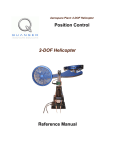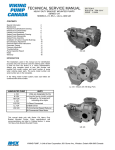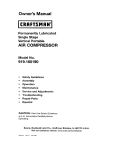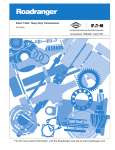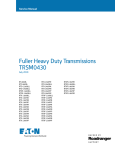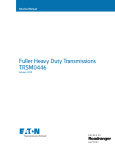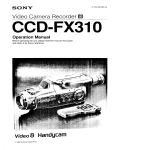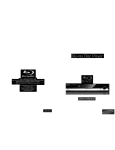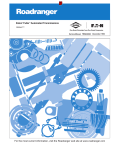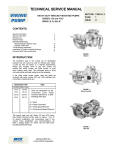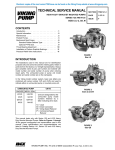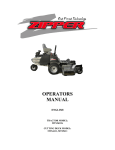Download Fuller Heavy Duty Transmissions TRSM0515
Transcript
Service Manual Fuller Heavy Duty Transmissions TRSM0515 October 2007 TABLE OF CONTENTS Timing Description Operations Lubrication Preventive Maintenance Torque Recommendations Air System Precautions Disassembly Front Section Disassembly Auxiliary Disassembly Auxiliary Reassembly Front Section Reassembly Reassembly Tool Reference Changing Clutch (Input Shaft) Eaton Corporation Transmission Division Kalamazoo, Mich. 49007 TIMIMG It is essential that the two countershafts are timed. This assures that the countershaft gears will contact the mating mainshaft gears at the same instant, allowing the mainshaft gears to seek their equilibrium position. This prohibits the mainshaft gears from climbing out of position and prevents unequal tooth contact. Timing one set of gears, the drive gear set, is all that is necessary. It is a simple procedure, consisting of marking the proper teeth prior to installation and meshing the teeth so marked. A. Marking countershaft drive gear teeth. C. Meshing marked countershaft gear teeth with marked drive gear teeth. (After installing drive gear and mainshaft assemblies, the countershaft bearings are installed to complete countershaft installation.) 1. When installing bearings on the left countershaft, mesh the marked countershaft gear tooth between two marked teeth on the drive gear. Repeat the procedure when installing the right countershaft bearings. (See Illustration C.) 1. Prior to placing each countershaft assembly into case, clearly mark on each drive gear the gear tooth which is directly over the keyway in gear. (See illustration A.) This tooth is stamped with an "O" to aid identification. C. COUNTERSHAFT GEAR TEETH MESHED WITH DRIVE GEAR TEETH FOR CORRECT TIMING D. Timing auxiliary section. A. TOOTH ON COUNTERSHAFT DIRECTLY OVER KEYWAY MARKED FOR TIMING B. Marking drive gear teeth. 1. Mark any two adjacent teeth on the drive gear. 2. Mark the two adjacent teeth on the drive gear which are directly opposite the first set marked. There should be an equal number of teeth between the markings on each side of gear. (See Illustration B.) (In the auxiliary section, the low speed gear set is marked for timing instead of the drive gear set.) 1. Mark any two adjacent teeth on the large mainshaft low speed gear, then mark the two adjacent teeth directly opposite„the same procedure as used when marking the front section drive gear. 2. On each auxiliary countershaft assembly, mark the tooth on the small low speed gear which is stamped with an "O". 3. Install the low speed gear and tailshaft assembly in auxiliary housing. 4. Partially install outer races of countershaft rear bearings in case bores. 5. Place the auxiliary countershaft assemsemblies into position, meshing marked tooth on each countershaft gear between marked teeth on low speed gear. Countershafts will be partially seated in rear bearing. Cut 7300A B. DRIVE GEAR TEETH CORRECTLY MARKED FOR TIMING 6. Fully install rear bearings to complete auxiliary countershaft installation. DESCRIPTION OPERATION SHIFTING THE 10 S P E E D R O A D R A N G E R RT-661O SERIES General Instructions The 10-speed Roadranger Transmissions provide ten selective ratios, evenly and progressively spaced and shifted with one lever. But you do NOT shift the Roadranger as you would a conventional transmission with an auxiliary or 2-speed axle, because there is no split-shifting. The shifting of the 10-speed Roadranger Transmissions is much simpler.. much easier, ALL SHIFTS ARE MADE WITH ONE LEVER . . . you use the RANGE CONTROL BUTTON ONE TIME ONLY during a sequence of up-shifts . . .and ONE TIME ONLY during a down-shift pattern. Why is the Roadranger different? The Roadranger is a 2-RANGE transmission consisting of a5-speed front section and an automatic 2-speed auxiliary section in ONE CASE. The ten forward speeds are secured by using a 5-speed shifting pattern TWICE–the first time with the transmission engaged in Iow gear or low range; the second time engaged in high gear or high range. By using the same shifting pattern twice, the TRANSMISSION shift lever position for 6th speed is the same as lst...7th the same as 2nd, 8th the same as 3rd, 9th the same as 4th, and 10th the same as 5th. Detailed Shifting Instructions In the following instructions, it is assumed that the driver is familiar with motor trucks and tractors, and that he can coordinate the necessary movements of the shift lever and clutch pedal to make progressive and selective gear engagements in either direction, up or down. Upshifting To get to high range pull button UP while in 5th speed, then move lever to 6th speed. Let's step into the cab. 1. Move the gear shift lever to the neutral position. 2. Start the engine. 3. Wait for air system to reach normal line pressure. 4. Now look at the Range Control Button. If it is up push it to the down position. (With the downward movement of the button, the transmission will shift into low range.) If the button was down when the truck was last used, the transmission is already in low range. 5. Now start the vehicle and shift progressively through 1st, 2nd, 3rd and 4th to 5th. 6. When is 5th and ready for the next upward shift, PULL the Range Control Button UP and move the lever to 6th speed. As the Iever passes through the neutral position, the transmission will automatically shift from low range to high range. 7. With the transmission in high range, you may now shift progressively through 7th, 8th and 9th to 10th. Driving tip: always start vehicle moving in first speed gear. A shift diagram should be in your vehicle. If your shift diagram has been misplaced, write to Service Department, Eaton Corporation, Transmission Division, Kalamazoo, Michigan, for replacement. Please specify model number of transmission. OPERATION Downshifting To get to low range push button DOWN while in 6th speed, then move lever to 5th speed. 1. When shifting down, move the lever from 10th through each successive lower speed to 6th. 2. When in 6th, and ready for the next downward shift, PUSH the Range Control Button DOWN and move the lever to 5th speed. As the lever passes through the neutral position, the transmission will automatically shift from high range to low range. 3. With the transmission in low range, shift down ward through each of the four remaining steps. Use Range Control Button only as described Don't shift from high range to low range at high speeds. Don't make range shifts with the vehicle moving in reverse gear. For 7-speed shifting with medium-heavy loads shift 2, 4, 6, 7, 8, 9, 10 For 8-speed shifting with heavy loads shift 2, 4, 5, 6, 7, 8, 9, 10 Skip-shifting is easy, too Skip-shifting is easy with the Roadranger transmission. Depending on the load, the RT-6610 can be shifted as a 6, 7, 8, 9 or 10 speed transmission. When you skip-shift going up make sure to pull the range control "up" to high range before the shift which passes 5th. Skip-shifting down, make sure to push the range control down to low range before the shift which passes 6th. Following are some suggested skip-shifting patterns: "Stop" sign or "Slow" sign When slowing down for a "stop" or "slow" sign, shift down through the individual short steps. By following this procedure the compression of the engine will slow the vehicle. The life of chassis and trailer brakes can thus be prolonged. Shifting the ® Fuller RT & RTO-6610 ® Roadranger Transmissions Ratios Models Ratios Rev. 9.50 8.94 7.00 5.46 4.26 3.42 2.61 2.05 1.60 1.25 1.00 2.78 1st For 6-speed shifting with light loads shift 3, 5, 7, 8, 9, 10 RT-6610 2nd 3rd 4th 5th 6th 7th 8th 9th RTO-6610 7.17 5.61 4.38 3.42 2.74 2.10 1.64 1.28 1.00 10th .80 7.62 2.23 LUBRICATION Proper Lubrication . . . the Key to long transmission life Recommended Lubricants Fahrenheit (Celsius) Grade Ambient Temperature Type (SAE) ® Eaton Roadranger CD50 Transmission Fluid Proper lubrication procedures are the key to a good all-around maintenance program. If the oil is not doing its job, or if the oil level is ignored, all the maintenance procedures in the world are not going to keep the transmission running or assure long transmission life. Eaton® Fuller ® Transmissions are designed so that the internal parts operate in a bath of oil circulated by the motion of gears and shafts. Thus, all parts will be amply lubricated if these procedures are closely followed: Mineral Gear Oil with rust and oxidation inhibitor API-GL-1 Eaton ® Roadranger ® CD50 Transmission Fluid HIGHWAY USE I Factory fill Initial drain, Check fluid level. Check for leaks. Every 250,000 miles (402336 Km) I I Change transmission fluid. OFF-HIGHWAY USE First 30 hours I I Proper Oil Level Make sure oil is level with filler opening. Because you can reach oil with your finger does not mean oil is at proper level. One inch of oil level is about one gallon of oil. Change transmission fluid where severe dirt conditions exist. Every 1,000 hours Change transmission fluid (Normal off-highway use). Heavy Duty Engine Lubricant or Mineral Gear Lubricant I Factory fill initial drain. First 3,000 to 5,000 miles (4827 to 8045 Km) Every 10,000 miles (16090 Km) Inspect lubricant level. Check for leaks. Every 50,000 miles (80450 Km) Change transmission lubricant. OFF-HIGHWAY USE Every 500 hours Every 1,000 hours Draining Oil Drain transmission while oil is warm. To drain oil remove the drain plug at bottom of case. Clean the drain plug before re-installing. Refilling Clean case around filler plug and remove plug from side of case. Fill transmission to the level of the filler opening. If transmission has two filler openings, fill to level of both openings. The exact amount of oil will depend on the transmission inclination and model. Do not over fill—this will cause oil to be forced out of the transmission, When adding oil, types and brands of oil should not be mixed because of possible incompatibility. I HIGHWAY USE Every 40 hours Above 1O”F,(-12”C.) Below IO”F.(-12°C,) Inspect fluid level, Check for leaks. Every 500 hours First 30 hours Above 10”E(-12”C.) Above 10”F.(-12”C,) Below 1O”F,(-12”C,) I Factory fill Initial drain. Every 40 hours I 90 80W All The use of mild EP gear oil or multi-purpose gear oil is not recommended, but if these gear oils are used, be sure to adhere to the following limitations: Do not use mild EP gear oil or multi-purpose gear oil when operating temperatures are above 230°F (110°C). Many of these gear oils, particularly 85W140, break down above 230°F and coat seals, bearings and gears with deposits that may cause premature failures. If these deposits are observed (especially a coating on seal areas causing oil leakage), change to Eaton Roadranger CD50 transmission fluid, heavy duty engine oil or mineral gear oil to assure maximum component life and to maintain your warranty with Eaton. (Also see “Operating Temperatures”.) Additives and friction modifiers are not recommended for use in Eaton Fuller transmissions. Lubrication Change and Inspection Every 10,000 miles (16090 Km) 50 Heavy Duty Engine 011 50 MIL-L-2104B, C or D or 40 API-SF or API-CD (Prewous API designations 30 acceptable) 1. Maintain oil level. Inspect regularly. 2. Change oil regularly. 3. Use the correct grade and type of oil. 4. Buy from a reputable dealer. First 3,000 to 5,000 miles (4827 to 8045 Km) ® Change transmission lubricant on new units. Inspect lubricant level. Check for leaks, Change transmission lubricant where severe dirt conditions exist. Change transmission lubricant (Normal of highway use), I I I I 4 LUBRICATION Operating Temperatures —With Eaton® Roadranger ® CD50 Transmission Fluid Heavy Duty Engine Oil and Mineral Oil The transmission should not be operated consistently at temperatures above 250°F (120°C). However, intermittent operating temperatures to 300°F (149°C) will not harm the transmission. Operating temperatures above 250°F increase the lubricant’s rate of oxidation and shorten its effective life. When the average operating temperature is above 250°F, the transmission may require more frequent oil changes or external cooling. The following conditions in any combination can cause operating temperatures of over 250°F: (1) operating consistently at slow speeds, (2) high ambient temperatures, (3) restricted air flow around transmission, (4) exhaust system too close to transmission, (5) high horsepower, overdrive operation. External oil coolers are available to reduce operating temperatures when the above conditions are encountered. Proper Lubrication Levels as Related to Transmission Installation Angles If the transmission operating angle is more than 12 degrees, improper lubrication can occur. The operating angle is the transmission mounting angle in the chassis plus the percent of upgrade (expressed in degrees). The chart below illustrates the safe percent of upgrade on which the transmission can be used with various chassis mounting angles. For example: if you have a 4 degree transmission mounting angle, then 8 degrees (or 14 percent of grade) is equal to the limit of 12 degrees. If you have a O degree mounting angle, the transmission can be operated on a 12 degree (21 percent) grade. Anytime the transmission operating angle of 12 degrees is exceeded for an extended period of time the transmission should be equipped with an oil pump or cooler kit to insure proper lubrication. Note on the chart the effect low oil levels can have on safe operating angles. Allowing the oil level to fall 1/2" below the filler plug hole reduces the degree of grade by approximately 3 degrees (5.5 percent). Proper Lubrication Levels are Essential! Transmission Oil Coolers are: Recommended — With engines of 350 H.P. and above with overdrive transmissions Required — With engines 399 H.P. and above with overdrive transmissions and GCW’S over 90,000 lbs. — With engines 399 H.P. and above and 1400 Lbs.-Ft. or greater torque — With engines 450 H.P. and above — With EP or Multipurpose Gear Oil Mild EP gear oil and multipurpose gear oil are not recommended when lubricant operating temperatures are above 230°F (110°C). In addition, transmission oil coolers are not recommended with these gear oils since the oil cooler materials may be attacked by these gear oils. The lower temperature limit and oil cooler restriction with these gear oils generally limit their success to milder applications. Transmission Mounting Angle Dotted line showing “2 Quarts Low” is for reference only. Not recommended. PREVENTATIVE MAINTENANCE CHECK CHART PREVENTIVE MAINTENANCE CHECK CHART CHECKS WITHOUT PARTIAL DISASSEMBLY 1. Air System and Connections a. Check for leaks, worn air lines, loose connections and capscrews. See Air System section. 2. Clutch Housing Mounting a. Check all capscrews in bolt circle clutch housing for looseness. 3. Clutch Release Bearing a. Remove hand hole cover and check wear. and axial clearance in release bearing. b. Check relative position of thrust surface of release bearing with thrust sleeve on push type clutches. 4. Clutch Pedal Shaft and Bores a. Pry upward on shafts to check wear. b. If excessive movement is found, remove clutch release mechanism and check bushings in bores and wear on shafts. 5. Gear Lubricant a. Change at specified service intervals. b. Use only gear oils as recommended. See Lubrication section. 6. Filler and Drain Plugs a. Remove filler plugs and check level of lubricant at specified intervals. Tighten filler and drain plugs securely. 7. Gear Shift Lever a. Check for looseness and free play in housing. If lever is loose in housing, proceed with Check No. 8. 8. Gear Shift Lever Housing Assembly a. Remove air lines at air valve and remove the gear shift lever housing assembly from transmission. b. Check tension spring and washer for set and wear. c. Check the gear shift lever pivot pin and pivot pin slot for wear. d. Check bottom end of gear shift lever for wear and check slot of yokes and blocks in shift bar housing for wear at contact points with shift lever. CHECKS WITH DRIVE LINE DROPPED 9. Universal Joint Companion Flange Nut (Not Shown) a. Check for tightness. Tighten to recommended torque. CHECKS WITH UNIVERSAL JOINT COMPANION FLANGE REMOVED 1 0 . Splines on Output Shaft a. Check for wear from movement and chucking action of the universal joint companion flange. 11. Mainshaft Rear Bearing Cover a. Check oil seal for wear. 12. Output Shaft a. Pry upward against output shaft to check radial clearance in mainshaft rear bearing. PREVENTATIVE MAINTENANCE CHECK CHART TORQUE RECOMMENDATIONS TORQUE RECOMMENDATIONS Cut 7191D-7/84 AIR SYSTEM AIR SYSTEM Basic Installation and Trouble Shooting Guide NOTE: If the transmission is equipped with a A-5010 Roadranger valve, see the Air Systems Troubleshooting Guide, TRSM-0920, for operation and assembly instructions . Operation The range shift air system consists of an air filter, regulator, air valve, control valve, range air cylinder which is built into the auxiliary housing, fittings, and connecting lines. Range shifts can only be made when the gear shift lever is in, or passing through, neutral. Thus, the range desired can be pre-selected while the shift lever is in a gear position. As the lever is moved through neutral, an actuating plunger in the shift bar housing releases the inter-lock piston allowing it to move to the range position selected. Constant regulated air is supplied to the "S" port of air valve and to the "IN" port of range control valve. With control button down, the control valve is open, and air passes through control valve and to the "P" port of slave valve. This permits air from the constant supply to flow through the low range port in slave valve to the air cylinder in auxiliary housing. Air at the cylinder moves the shift piston and shaft to the rear to engage the low range gear. With the control button up, the control valve is closed, and air is removed from end port of slave valve. This permits movement of the air valve poppet; air from the constant supply to flow through the high range port of the slave valve and to the high range port of range cylinder cover in auxiliary housing. The shift piston and shaft are moved forward to engage the high range or direct gear. When the control button is moved from one position to another, air from the previously charged Iine exhausts through the breather in range control valve. AIR SYSTEM TROUBLE SHOOTING RANGE SHIFT AIR SYSTEM If transmission fails to make a range shift or shifts too slow, the fault may be in the air system or actuating parts in the shifting bar housing. To check the air system and pin-point the trouble area, the following procedures are recommended, using the check points indicated by letters in the diagram on page 11. Checks are to be made with the vehicle engine off, but with normal vehicle air pressure. 1. Incorrect Hook-up With normal vehicle air pressure and gear shift lever in the neutral position, move the control button up and down, from one range to another. a. If lines are crossed between the control valve and the air valve on transmission, there will be a steady flow of air from the bottom exhaust in control valve with button in the up position. b. If lines are crossed between the air valve on transmission and the range cylinder, the transmission gearing will not correspond with the button position. Low range, down position of button, will result in high range gear engagement in the transmission and vice versa. 2. Air Leaks With normal vehicle air pressure and gear shift lever in the neutral position, coat all air lines and fittings with soapy water and check for leaks, moving control button to both positions. a. If there is a steady leak out exhaust of range control valve, there are defective parts or O-rings in the range control valve. b. If there is a steady leak out breather on slave valve: there is a defective O-ring in the slave valve, or there is a leak past O-rings on the range shift cylinder piston. c. If transmission fails to shift into low range or is slow to make the shift and the transmission case is pressurized, see Check Point E. d. Tighten all loose connections and replace defective parts or O-rings. 3. Check Point A, Air Regulator With normal line pressure and gear shift lever in neutral, check exhaust port of air regulator. There should be no leak from this port. Cut off the vehicle air pressure and install air gauge in line at output port of air regulator. Bring vehicle air pressure to normal. Regulated pressure should be 57.5 to 62.5. Only as a last resort should an adjustment be made with the screw in bottom of regulator. This adjustment has been set for correct operating limits. Any deviation from these limits, especially on regulators which have been in operation for some time, will in most cases be caused by dirt or worn parts. Adjustment of screw will give only a temporary remedy. (1) Turning screw in (clockwise) raises air pressure. (2) Turning screw out lowers air pressure. Air regulator is not serviceable and should be replaced if defective. 4. Check Point B With normal vehicle air pressure and lever in the neutral position, pull the up to high range and disconnect the line from out port of control valve at the gear shift control button 1/8Ó nylon air the air valve. a. When control button is pushed down a steady blast of air will flow from disconnected line. Air will shut off when button is pulled up. This indicates that control valve is operating correctly. Reconnect air line. b. If control valve does not operate correctly, check for restrictions and leaks; leaks indicate bad O-rings. 5. Check Point C With normal vehicle air pressure and gear shift lever in the neutral position, push the control button down to the low range position and disconnect the high range air line, either at fitting on shift cylinder or at side port or slave valve. a. Pull the control button up. There should be a steady flow of air from the high range port. Push button down to shut off air. b. Make sure vehicle engine is off and move the gear shift Iever to a gear position. Pull the button up; there should be no air at high range port. Move the gear shift lever to neutral; there should now be a steady flow of air from the high range port. Push button down to shut off air and reconnect the high range air line. c. If air system operates incorrectly, this indicates that the slave valve is defective, or that actuating parts in shifting bar housing are jammed or defective. AIR SYSTEM 6. Check Point D With normal vehicle air pressure and gear shift lever in the neutral position, pull the control button up to high range and disconnect the low range air line, either at fitting on range cylinder or at bottom port of air valve. a. Repeat procedures under Check Point C, reversing the position of the control button in order to check the low range operation. 7. Check Point E If any of the seals in the range shift cylinder are defective the range shift will be affected. The degree of lost air will govern the degree of failure, from slow shift to complete failure. a. Leak at seal A or B as shown in diagram results in failure to shift into either low or high range; steady leak out air valve breather in both ranges. b. Leak at seal C results in failure to shift into low range; pressurizing of transmission. Check Point E„ Cross section of range shift cylinder, showing location of seals. Air Valve Pre-Selection An actuating pin protruding from the shifting bar housing prevents the poppet slave valve from moving while the gear shift lever is in a gear position and releases the poppet when the lever is moved to or through neutral. See detailed installation of air valve for installation precaution concerning the actuating pin. AIR SYSTEM IV. RANGE SHIFT AIR LINESãALL MODELS Cut 7001 D-7/84 A. Removal B. Installation 1. Disconnect the black and white l/8" OD air lines (A and B) from between the slave air valve and the range shift control valve. 1. Connect the black and white 1/8" OD supply air line between the forward port on the slave air valve and the rear port on the range shift control valve. 2. Disconnect the two 1/4" ID air lines from between the slave air valve and the range shift cylinder. 2. Install the black l/8" OD signal air line between the rear port on the slave air valve and the forward port on the range control valve. 3. Use the chart to install the 1/4" ID air lines between the slave air valve side cap and the range shift cylinder. AIR SYSTEM VI. RANGE CONTROL VALVE A. Removal and Disassembly B. Reassembly and Installation 1. Disconnect the air lines and loosen the clamp securing the valve to the gear shift lever. Remove valve. 1. Refer to the drawing for proper reassembly. Use a VERY SMALL amount of silicone lubricant on the O-rings to avoid clogging the ports. A small amount of grease on the position springs and balls will help to hold them in place during reassembly. 2. Remove the four screws to separate the front and rear housings and remove the slide and two sets of position springs and balls. 3. Remove the valve plate, insert O-rings and wave washer from the valve bodies. 4. If necessary, remove the two felt seals. Punch out the roll pin to remove the button from the slide. 2. Install the air lines with their sheathing and O-rings on the gear shift lever. 3. Secure the valve on the gear shift lever with the clamp. The control button should face to the front and be approximately 6" below the centerline of the shift knob or selector valve. 4. Attach the air lines. AIR SYSTEM AIR FILTER AND REGULATOR The air filter contains a replaceable filter element which can be removed by turning out the end cap and removing the spring and tension plate. This element should be cleaned at each oil change, or more often under high humidity conditions. PRECAUTIONS DISASSEMBLY It is assumed in the detailed disassembly instructions that the lubricant has been drained from the transmission, the necessary linkage and air lines removed and the transmission has been removed from the chassis. Removal of the gear shift lever housing assembly is included in the detailed instructions; however, this assembly must also be removed from transmission before removing unit from vehicle. Follow each procedure closely in each section, making use of both the text and pictures. 1. BEARINGS - Carefully wash and relubricate all bearings as removed and protectively wrap until ready for use. Remove bearings with pullers designed for this purpose. 2. ASSEMBLIES - When disassembling the various assemblies, such as the mains shaft, countershafts and shifting bar housing, lay all parts on a clean bench in the same sequence as removed. This procedure will simplify re-assembly and reduce the possibility of losing parts. 3. SNAP RINGS - Remove snap rings with pliers designed for this purpose. Rings removed in this manner can be reused. 4. INPUT SHAFT - The input shaft can be removed without removing the countershafts, mainshaft or drive gear. 5. CLEANLINESS - Provide a clean place to work. It is important that no dirt or foreign material enters the unit during repairs. The outside of the unit should be carefully cleaned before starting the disassembly. Dirt is abrasive and can damage bearings. 6. WHEN DRIVING - Apply force to shafts, housings, etc., with restraint. Movement of some parts is restricted. Do not apply force after the part being driven stops solidly. Use soft hammers and bars for all disassembly work. INSPECTION Before reassembling the transmission, the individual parts should be carefully checked to eliminate those damaged from previous service. This inspection procedure should be carefully followed to insure the maximum of wear life from the rebuilt unit. The cost of a new part is generally a small frac- tion of the total cost of downtime and labor, should the use of a questionable part make additional repairs necessary before the next regularly scheduled overhaul. Recommended inspection procedures are set forth in the following check list: PRECAUTIONS A. Bearings G. Clutch Release Parts 1. Wash all bearings in clean solvent. Check balls, rollers and races for pits and spalled areas. Replace bearings which are pitted or spalled. 1. Check clutch release parts. Replace yokes worn at cam surfaces and bearing carrier worn at contact pads. 2. Lubricate bearings which are not spalled or pitted and check for axial and radial clearances. Replace bearings with excessive clearances. 2. Check pedal shafts. Replace those worn at bearing surfaces. 3. Check fit of bearings in case bores. Bearings should be tight to shaft, slightly tight to slightly loose to bearing bore. H. Shifting Bar Housing Assembly 1. Check yokes and blocks for wear at pads and lever slot. Replace worn parts. B. Gears 2. Check yokes for alignment. Replace those which are sprung. 1. Check operating gear teeth for pitting on the tooth faces. Gears with pitted teeth should be replaced. 3. Check yokes for excessive wear; replace worn yokes. 2. Check all engaging gear teeth. Gears with teeth worn, tapered or reduced in length from clashing in shifting should be replaced. 3. Check axial clearances of gears. Where excessive clearance is found, check gear snap ring, washer, spacer and gear hub for excessive wear. Maintain .005 to .012 axial clearance of mainshaft forward speed gears, .005 minimum on reverse gear. C. Splines 1. Check splines on all shafts for wear. If sliding clutch gears, companion flange or clutch hub have worn into the sides of the splines, the shafts in this condition should be replaced. D. Thrust Washers 4. Check Iockscrews in yokes and blocks. Retorque and rewire those found loose. 5. If housing has been dismantled, check neutral notches of shifting bars for wear from interlock balls. Bars indented at points adjacent to the neutral notch should be replaced. I. Gear Shift Lever Housing Assembly 1. Check spring tension on shift lever. Replace tension spring and washer if lever moves too freely. 2. If housing is dismantled, check pivot or spade pin and corresponding slot in lever for wear. Replace both parts if worn. J. Oil Return Threads and Seals 1. Check surfaces of all thrust washers. Washers scored or reduced in thickness should be replaced. 1. Check oil return threads in front bearing cover. If sealing action of threads has been destroyed by contact with input shaft, replace the cover. E. Reverse Gear and Shaft 2. Check oil seal in mainshaft rear bearing cover. If sealing action of lip has been destroyed, replace seal. 1. Check bearing sleeve for wear from action of roller bearings. F. Gray Iron Parts 1. Check all gray iron parts for cracks and breaks. Replace or repair parts found to be damaged. Heavy castings may be welded or brazed providing the cracks do not extend into bearing bores or bolting surfaces. PRECAUTIONS K. Synchronizers 3. O-RINGS - Lubricate all O-Rings with silicone lubricant. 1. Check high and low range synchronizers for burrs, uneven and excessive wear at contact surface, and metal particles. 4. ASSEMBLY - Refer to the disassembly illustrations as a guide to reassembly. 2. Check blocker pins for excessive wear or looseness. 3. Check synchronizer contact surfaces on the high and low range gears for excessive wear. 5. INITIAL LUBRICATON - Coat all thrust washers and splines of shafts with Lubriplate during installation to provide initial lubrication, preventing scoring and galling. L. Sliding Clutches 1. Check all yokes and yoke slots in sliding clutches for wear or discoloration from heat. 6. AXIAL CLEARANCES - Maintain original axial clearances of mainshaft forward speed gears of .005" to .012". Mainshaft reverse gear clearance is a minimum of .005". 2. Check engaging teeth of sliding clutches for partial engagement pattern. M. O-Rings 7. BEARING - Use of flanged-end bearing drivers is recommended for the installation of bearings. These drivers apply equal force to both races of bearing, preventing damage to balls and races and maintaining correct bearing alignment with shaft and bore. If tubular or sleeve type driver is used, apply force only to inner race. 1. Check all O-rings for cuts, cracks or distortion. Replace if worn. REASSEMBLY Make sure that interiors of case and housings are clean. It is important that dirt be kept out of transmission during reassembly. Dirt is abrasive and can damage polished surfaces of bearings and washers. Use certain precautions, as listed below, during reassembly. 8. UNIVERSAL JOINT COMPANION FLANGE Pull the companion flange tightly into place with the mainshaft nut, using 400-450 foot-pounds of torque. Make sure the speedometer gear has been installed on yoke. If a speedometer gear is not used, a replacement spacer of the same width must be used. Failure to pull the yoke or flange tightly into place will permit the shaft to move axially with resultant damage to rear bearing. 1. GASKETS - Use new gaskets throughout the transmission as it is being rebuilt. Make sure all gaskets are installed, as omission of gasket can result in oil leakage or misalignment of bearing covers. See "Location of Gaskets" heading. 2. CAPSCREWS - To prevent oil leakage, use thread sealant on all capscrews. See torque rating chart for recommended torque. 9. TORQUE - As you reassemble transmission, refer to pages 12 and 13 for proper installation torque of capscrews, nuts and plugs. 23 DISASSEMBLY I. RANGE SHIFT AIR SYSTEM A. To Remove the Range Shift Control Valve. 1. Disconnect the two nylon air lines at air valve on transmission. NOTE: If desired, the gear shift lever housing lever and range control valve can now be removed from the transmission as a unit by turning out the four capscrews which attach the housing to the transmission. 2. Disconnect the two nylon air lines at the control valve on gear shift lever, and remove the ball grip from gear shift lever. DISASSEMBLY C. To Remove the Slave Valve. 3. Loosen the mounting clamp and remove the range control valve and mounting clamp from lever. 4 . Remove nylon air lines, sheathing and O-ring clamp from the gear shift lever. B. To Remove Air Regulator and Filter Assembly. 1. Remove the two air lines between the slave valve and range cylinder in auxiliary. 2. Turn out the four capscrews and remove the slave valve from transmission. Remove sleeve from slave valve. 1. Disconnect and remove the air line between the slave valve and air regulator. 3. If necessary, remove fittings from slave valve. 2. Remove street ell and reducer from regulator if necessary. 3. Turn the nipple from air regulator. 4. Turn out capscrews and remove the air regulator and filter assembly from transmission. 4. Remove the actuating spring and pin from bore in transmission. SHIFTING CONTROLS IX. GEAR SHIFT LEVER HOUSING I SHIFT CONTROLS A. Removal and Disassembly B. Reassembly and Installation 1. Turn out the capscrews, jar lightly to break the gasket seal and remove the gear shift lever housing from the shift bar housing. 1. Install the spade pin or pivot pin, nut and washer in the bore in the housing. If previously removed, install the O-ring in the groove. 2. Secure the housing in a vise and use a large screwdriver to twist between the spring and side of the housing, forcing the spring from under the three lugs. Do one coil at a time. Remove the spring. 2. Install the gear shift lever in the housing, fitting the slot in the lever ball over the spade pin. 3. Remove the washer and gear shift lever. 4. Seat the tension spring under the lugs in the housing, seating one coil at a time. Use of a spring driving tool is recommended. 3. Place the tension spring washer over the lever ball with the dished side up. 4. Remove the spade pin or pivot pin, nut and washer from the bore in the housing. If necessary, remove the O-ring from the housing. 5. Make sure that the three tension springs and balls are in the shift bar housing bores and install the gear shift lever housing and gasket on the shift bar housing. 27 DISASSEMBLY Ill. SHIFTING BAR HOUSING A. To Remove and Disassemble the Shifting Bar Housing. 1. Turn out the attaching capscrews, jar to break gasket seal, and lift the shifting bar housing from transmission. 2. Turn out the two capscrews and remove the tension spring cover from top of housing. 3. Remove the three tension springs installed under cover. 28 DISASSEMBLY 4. Tilt housing and remove the three tension balls installed under springs. 7. Move top shifting bar to the right and out of housing, removing shifting yoke-from bar. 5. Place the housing in a vise with the plunger side up; front of housing will be to the right. 8. Move center bar to the right and out of housing, removing shifting yoke from bar. As neutral notch in bar clears the front web, remove the interlock pin from bore in neutral notch. 6. Starting with the upper bar, move all bars to the right and out front of housing as detailed in the following instructions. Cut lockwire an d remove Iockscrews from each bar just prior to its removal. NOTE: During disassembly, lay all parts on a clean bench in the order of removal to facilitate reassembly. Bars not being removed must be kept in the neutral position or interlock parts will lock bars. DISASSEMBLY 9. Remove the actuating plunger from rear web. 10. Move the lower bar to the right and out of housing, removing shifting yoke from bar. 11. Remove the two interlock balls from front web. DISASSEMBLY IV. COMPANION FLANGE, AUXILIARY SECTION AND CLUTCH HOUSING REMOVAL A. To Remove the Universal Joint Companion Flange or Yoke. 1. Lock the transmission by engaging two speeds with the mainshaft sliding clutches. Use a large breaker bar to turn the output shaft nut from the output shaft. 2. Pull the flange or yoke straight to the rear and off shaft. DISASSEMBLY B. To Remove the Auxiliary Section from Transmission. C. To Remove the Clutch Housing and Front Bearing Cover. 1. Remove the clutch release mechanism if so equipped. 1. Turn out the capscrews that attach the two sections. 2. Remove nuts from the six studs and turn out the two bolts which attach clutch housing to case. 3. Break gasket seal and remove clutch housing from case. 2. Insert puller screws in auxiliary housing flange. 3. Tighten puller screws evenly to move the auxiliary section straight to the rear and from front section. 4. Turn out capscrews and remove the front bearing cover. (Tap against drive gear from inside case to move cover forward to break gasket seal.) DISASSEMBLY V. FRONT SECTION DISASSEMBLY A. To Remove Bearings from Right Countershaft. 1. Remove snap ring in rear bearing bore of case. 2. Using soft bar and maul against rear of countershaft, move the assembly forward as far as possible until snap ring groove in front bearing is exposed. NOTE: If front bearing snap ring groove can not be exposed (due to variances in thickness of case), use punch between hub of countershaft drive gear and inner race of bearing to move the gear forward on shaft. 3. Install snap ring in the exposed bearing snap ring groove. (Use snap ring which was removed from rear bearing bore.) 4. Loosen the capscrews at the bearing retaining rings on auxiliary drive gear. This will allow movement to the rear of the countershaft and mainshaft assemblies. FRONT SECTION DISASSEMBLY 5. Using soft bar and maul against front of countershaft, move the countershaft assembly to the rear as far as possible. This will move front bearing forward on shaft. 6. Using soft bar and maul against rear of countershaft, again move the countershaft as far forward as possible to unseat front bearing from case bore. 7. Use puller or pry bars to remove front bearing. 8. Use a maul and punch from inside the case to drive the rear bearing to the rear and from the case bores. NOTE: Removal procedures will damage the bearings and removal should not be attempted unless replacement of the bearings is planned. FRONT SECTION DISASSEMBLY B. To Remove the Input Shaft. 1. Move the drive gear and shaft forward as far as possible. 2. Remove the bearing retaining snap ring from groove in shaft. 3. Push down on input shaft to cock bearing in bore. Drive input shaft toward rear of transmission, through bearing as far as possible. Pull input shaft forward to expose snap ring of bearing. 4. Use pry bars to complete removal of bearing. FRONT SECTION DISASSEMBLY .-Ó 8. If necessary, remove bushing from pocket in clutch shaft. 5. Remove the drive gear washer. 6. Remove the snap ring from groove in ID of drive gear. 7. Pull shaft forward and from splines of drive gear. 9. Move the drive gear to the rear and against the 4th speed gear, engaging teeth of sliding clutch gear. FRONT SECTION DISASSEMBLY Cut 6421 -2/80 C. To Remove and Disassemble the Auxiliary Drive Gear Assembly. 2. Remove the snap ring from the rear of mainshaft (located in bore of auxiliary drive gear). 1. Turn out capscrews and remove the two bearing retainer rings from case. 3. Tap against front of mainshaft to move the auxiliary drive gear bearing to the rear, exposing the bearing snap ring. FRONT SECTION DISASSEMBLY 4. Use pry bars to remove the auxiliary drive gear assembly from case bore and from splines of mainshaft. 5. Remove snap ring from groove in auxiliary drive gear. 6. Press or use driver to remove bearing from auxiliary drive gear. FRONT SECTION DISASSEMBLY D. To Remove the Left Reverse Idler Gear. 2. Remove the rear idler washer and retainer from bore. (If necessary, bend holder lugs and remove washer from holder.) 1. Use curved pry bar to walk bearing from idler bore in case. FRONT SECTION DISASSEMBLY 3. Remove reverse idler gear from case. 4. Remove the idler bearing from reverse idler gear. 5. Remove the front idler washer from case FRONT SECTION DISASSEMBLY E. To Remove and Disassemble the Mainshaft Assembly. . 1. Block the right countershaft to the right as far as possible-and lift the mainshaft assembly from case. 2. Remove the drive gear and the 4th-5th sliding clutch from mainshaft. 3. Inside hub of the 4th speed gear, remove snap ring from groove in mainshaft. 4. Remove the 4th speed gear and washer. FRONT SECTION DISASSEMBLY 5. Remove the 3rd speed gear and washer. 7. Remove the long key from slot in mainshaft. 6. Remove the 2nd-3rd speed sliding clutch. 8. Remove the 2nd speed gear and washer. FRONT SECTION DISASSEMBLY 9. Remove the 1st speed gear and washer. 10. Remove the 1st-reverse sliding clutch. 11. Remove the reverse gear and washer. FRONT SECTION DISASSEMBLY F. To Remove the Countershaft Assemblies. 3. Lift the left countershaft from case. 1. Lift the right countershaft from case. 2. Remove bearings from the left countershaft in the same manner in which bearings were removed from right countershaft. (See pages 33 and 34.) FRONT SECTION DISASSEMBLY G. To Disassemble the Countershaft Assemblies. NOTE: Both countershafts are disassembled in the same manner as construction is identical. 3. Press the 4th speed gear from shaft. 1. Remove snap ring from front of countershaft. 2. Press the drive gear from shaft. 4. Using the rear face of the PTO gear as a base in press, press the 3rd speed gear, and the PTO-2nd speed gear cluster from shaft. 5. If necessary, remove woodruff key, long key and roll pin from shaft. H. To Remove the Right Reverse Idler Gear. The right reverse idler gear assembly is identical to the left and is disassembled in the same manner. FRONT SECTION DISASSEMBLY VI. AUXILIARY DISASSEMBLY Cut 6482 Ð2/80 A. To Remove the Auxiliary Countershaft Assemblies. 2. Turn out capscrews and remove the rear bearing cover. 1. Use pullers to remove bearing from front of tailshaft. 3. If necessary remove the rear seal from cover. AUXILIARY DISASSEMBLY 4. Remove the speedometer gear or replacement spacer from tailshaft. 5. Remove the speedometer gear washer. 6. 7. Pull the counters shafts forward and out of housing. From inside housing, use long punch to move outer races of countershaft rear bearings to the rear; move races approximately one-half inch. 8. If necessary pull bearing inner races from front and rear of countershaft. (Rear race removal is shown.) AUXILIARY DISASSEMBLY I C. To Remove the Range Shift A i r C ylin d er an d Synchronizer Assemblies. 3. Use air to remove piston. CAUTION - DO not stand in front of cylinder opening. 1. Turn out capscrews and remove the air cylinder cover. 4. If necessary remove O-ring from OD of piston. 2. Remove the nut and Iockwasher from air cylinder piston shaft. AUXILIARY DISASSEMBLY 5. Remove the copper seal from shaft. . 6. Move the synchronizer assembly, shift yoke, and piston shaft forward and out of housing as a complete assembly. 9. Place the larger low range synchronizer ring on bench. 10. Pull upward to remove the high range synchronizer from pins. CAUTION. There are three springs located in housing of high range synchronizer which will be released as high range synchronizer is removed from pins. It may be helpful to cover assembly with rag to prevent losing springs. 11. Remove the sliding clutch from low range synchronizer pins. - D. To Remove and Disassemble the Air Cylinder Assembly. 7. Remove the shaft and yoke from synchronizer assembly. 8. Cut lockwire, turn out the two Iock screws and remove yoke from shaft. 1. Important: Remove the dust seal, and air port extension from top of housing. AUXILIARY DISASSEMBLY E. To Remove and Disassemble the Low Speed Gear and Tailshaft Assembly. 2. Remove cylinder from housing. 1. Drive or press against rear of tailshaft to move assembly forward and from rear bearing. 3. Remove O-ring from small bore in cylinder, if necessary. 2. Remove the rear washer and the low speed gear from rear of shaft. AUXILIARY DISASSEMBLY 3. Remove spline washer from hub of low speed gear. 4. Move the mainshaft rear bearing to the rear and out of housing. 5. Use bearing driver to remove the countershaft rear bearings from housing. AUXILIARY REASSEMBLY I. AUXILIARY REASSEMBLY Cut 6549-9/85 A. To Reassemble and Install the Low Speed Gear and Tailshaft Assembly. 1. Make sure magnetic cleaner is installed in recess in auxiliary case. 3. Place splined spacer in hub of low speed gear, shoulder toward rear. 2. IMPORTANT: Mark timing teeth on the reduction gear. a. Mark any two adjacent gear teeth on low speed gear. b. Then, mark the two adjacent teeth which are directly opposite the first set marked. There should be the same number of teeth between the markings on each side of the gear. 4. Install the low speed gear and spacer over rear of shaft and against shoulder. Clutching teeth down. AUXILIARY REASSEMBLY 5. Install the low speed gear rear washer on shaft and against gear, chamfer to the rear. 6. Set the tailshaft with the forward end down and place auxiliary housing over rear of shaft so that shaft extends through rear bore. 7. Seat mainshaft rear bearing securely on shaft and in bore. AUXILIARY REASSEMBLY B. To Install the Range Shift Air Cylinder. 1. Install O-ring in slot in small bore in cylinder. Lubricate O-ring with silicone lubricant. 2. Install range cylinder in housing with air port in cylinder aligned with air port in top of auxiliary housing. AUXILIARY REASSEMBLY 3. Install dust cover and airport extension through housing and into bore of air cylinder. C. To Reassemble the Synchronizer Assembly. 3. Install the three springs in bores in high range synchronizer ring. 1. Place the larger low range synchronizer ring face down on bench with pins up. 2. Place the sliding clutch, recessed side up, on pins of low range synchronizer. 4. Place the high range synchronizer ring over pins of the low speed synchronizer ring, seating springs against pins. AUXILIARY REASSEMBLY 5. Seat the direct ring fully on the low speed pins by pushing down and twisting to compress the springs. D. To Install the Synchronizer and Range Shift Air Cylinder Assemblies. 1. Place the shifting yoke on piston shaft, long hub towards the rear of the shaft. 2. Align slots in shaft with bores in Yoke hub and install the two Iockscrews secure with safety wire. 3. Place yoke in slot of sliding clutch; threaded end of piston shaft is towards the larger low range synchronizer. 4. Place the entire assembly into auxiliary housing, exgaging splines or sliding clutch with tai lshaft and inserting piston shaft through cylinder bore. 5. Install copper seal on threaded end of piston shaft. AUXILIARY REASSEMBLY 6. Install O-ring on OD of piston. Apply light coat of silicone lubricant to O-ring. -. 7. Install piston on shaft and against copper washer, flat side of piston out. 9. Install gasket and cylinder cover, tighten the four capscrews securely. E. To Reassemble the Countershaft Assemblies. 1. Install bearing inner race on front and rear of countershaft. 2. IMPORTANT: To mark countershaft gear teeth for timing. 8. Install Iockwasher and nut on shaf to secure piston. Mark the tooth on the countershaft low speed gear which is stamped with an "O". AUXILIARY REASSEMBLY F. To Install the Countershaft Assemblies. 3. With countershafts in position, complete the installation of the countershaft rear bearings on shaft and into case bore. Seat securely. 1. Seat the outer races of the countershaft rear bearings only partially in bores, just far enough to stay in place. 2. Place countershafts into position in auxiliary housing, inserting inner races into the partially installed outer races. IMPORTANT: Timing countershaft gears with low speed gears. As the countershafts are installed, mesh the marked low speed gear tooth on each countershaft between each set of marked gear teeth on the low speed gear. AUXILIARY REASSEMBLY 4. Install the speedometer gear rear washer on tailshaft and against bearing, champh ered ID towards bearing, and install the speedometer gear or replace merit spacer on shaft and against washer. 5. If previously removed, install oil seal in rear bearing cover, lip of seal to the rear. The spring in the seal should be toward the inside of the transmission. 6. Install the rear bearing cover with the speedometer bore up and to the left, tighten cap screws securely. 7. Install bearing on front of tailshaft. FRONT SECTION REASSEMBLY Il. FRONT SECTION REASSEMBLY A. To Install the Right Reverse Idler Gear Assembly. 3. Install needle bearing through rear bore and into hub of reverse gear. 1. Apply a heavy coat of white grease on the reverse-idler gear front washer and install it on pin in lower right of case. 4. Place rear washer in holder if previously removed, and bend lugs to secure washer. 5. Place washer and holder into reverse gear case bore, holder flange to the rear. 2. Set reverse gear in position next to washer, machined surface of gear hub to the rear. 6. Install the auxiliary countershaft front bearing into the reverse gear case bore to hold the reverse idler gear assembly in position. NOTE: The front portion of the auxiliary countershaft is used as a journal for the reverse idler gear. FRONT SECTION REASSEMBLY B. To Assemble the Countershaft Assemblies. NOTE: Countershafts are identical and are assembled in the same manner. 3. Press the 3rd speed gear on shaft. 1. If previously removed, install roll pin, long key and woodruff key in slots in countershaft. 4. Press the 4th speed gear on shaft, long hub to the front. 2. Press the PTO-2nd speed gear cluster on countershaft, PTO gear to the front. FRONT SECTION REASSEMBLY C. To Mark Timing Teeth and Position Countershaft Assemblies. 1. On the drive gear of each countershaft mark the gear tooth which is aligned with the keyway in shaft. This tooth will be stamped with an "O". 5. Press drive gear on shaft, long hub to the rear. 2. Place the left countershaft into position in case - install bearings as shown in illustrations 4, 5, 6 and 7. 6. Install snap ring in groove at front of shaft. 3. Place the right countershaft into position in case--do not install bearings. FRONT SECTION REASSEMBLY 4. Center rear of left countershaft in rear bore of case with block. 7. Install snap ring in groove in rear bore of case. D. To Assemble Auxiliary Drive Gear Assembly. 5. Install front bearing on countershaft and in case bore with flanged driver. 6. Install rear bearing on countershaft and in case bore with flanged driver. 1. Press bearing on auxiliary drive gear, snap ring in groove towards gear. 2. Install bearing retaining snap ring in groove of auxiliary drive gear shoulder. FRONT SECTION REASSEMBLY E. To Reassemble the Mainshaft Assembly. 3. Install long key, from the bottom, in keyway in mainshaft to lock reverse gear splined washer to mainshaft. 1. Place the mainshaft in a vise with the pilot end down. Keep keyway in mainshaft clear for insertion of key. NOTE: Each mainshaft gear is held in position by locking the gear splined washer to the mainshaft with key. There is one splined washer for each gear. Splined washers for the reverse, 1st, 2nd, and 3rd speed gears are the same diameter, the 4th speed gear splined washer is of smaller diameter. 4. Install reverse gear on splined washer with clutching teeth facing down. 2. Install reverse gear splined washer in groove near rear of mainshaft. NOTE: Make sure long key is positioned with the word "top" on key to the outside. During reassembly the long key will be removed and re-installed to assure that washers stay in position. 5. Install auxiliary drive gear on mainshaft with clutching teeth facing up. FRONT SECTION REASSEMBLY SETTING CORRECT AXIAL CLEARANCES FOR MAINSHAFT GEARS Axial Clearance (End Play) Limits Are: Reverse speed gear - Minimum of .005" Forward speed gears - .005" to .012" Washers are used to obtain the correct limits; Five thicknesses are available as follows: LIMITS COLOR CODE .259 -.261 .264 -.266 .269 -.271 .274 -.276 .279 -.281 Orange Purple Yellow Black Red Refer to Illustrated Parts Lists for washer part numbers. Always use the low limit washer in the 1st GEAR and 3rd SPEED GEAR positions as shown at right. Refer to the service manual covering mainshaft reassembly for method of assembling parts. Reverse gear clearance must be set as low as possible to the minimum .005". Clearance can be measured before the mainshaft assembly is installed in the case. This is done by securing the reverse gear in position on mainshaft with the reverse gear snap ring and the front snap ring; then, secure auxiliary drive gear assembly in position at rear of mainshaft with the rear snap ring. **On overdrive models, the (4th) speed gear becomes (5th) speed gear. FRONT SECTION REASSEMBLY 6. Install snap ring in groove at rear of m/shaft. 9. Install the 1st-reverse clutch over front of mainshaft and against reverse gear splined washer. Align slot in sliding clutch with key. 7. Insert two large screw drivers between hub of reverse gear and auxiliary drive gear applying light downward pressure on handles of screwdrivers. 10. Remove long key from keyway in mainshaft. Install 1st speed gear splined washer on mainshaft at 1st speed gear location and re-install the long key to lock splined washer to shaft. 8. Check clearance between the two gears with feeler gauge. Clearance can be adjusted by replacing reverse gear splined washer with different thickness washer. Proper clearance at this location should be a minimum of .005". After proper reverse gear clearance has been set, remove snap ring from rear of mainshaft in vise, place front (pilot end) of mainshaft in vise. FRONT SECTION REASSEMBLY 11. Install 1st speed gear on mainshaft, clutching teeth down, fitting gear splines on those of washer. 13. Remove the long key from keyway in mainshaft. 14. Install 2nd speed gear splined washer on mainshaft and into hub of 2nd speed gear. 12. Install 2nd speed gear on mainshaft, clutching teeth up, and against 1st speed gear. 15. Install long key in keyway in mainshaft to lock washer to shaft. FRONT SECTION REASSEMBLY 16. Insert 2 large screwdrivers between the 2 gears. Apply slight downward pressure then insert feeler gauge between the hubs of the gears to check axial clearance. Correct clearante should be .005" to .012". 18. Install 3rd gear splined washer on mainshaft at 3rd speed gear location. It will be necessary to pull long key upward slightly in order to fit splined washer over key cross pin and to fit key in keyway. Re-position key so that cross pin rests on top of washer. 17. Install the 2nd-3rd speed sliding clutch, aligning slot in sliding clutch with key; engage with 2nd speed gear. 19. Install the 3rd speed gear on mainshaft, fitting gear splines on those of washer. FRONT SECTION REASSEMBLY 20. Install the 4th speed gear on mainshaft (clutching teeth up) and - against 3rd speed gear. 22. Install snap ring in groove in mainshaft which will hold the 4th speed gear in position on shaft. 21. Install the 4th speed gear splined washer on mainshaft and in hub of 4th speed gear. 23. Install the 4th-5th speed sliding clutch on mainshaft, engage clutch with 4th speed gear. The side marked "front" should be facing up. FRONT SECTION REASSEMBLY 24. IMPORTANT: Mark timing teeth on drive gear (5th speed gear). a. Mark two adjacent teeth on drive gear. b. Mark the two adjacent teeth on drive gear which are directly opposite the first set marked. There should be the same number of teeth between markings on each side of gear. 26. Remove the assembly from vise and install the reverse gear on rear of mainshaft, engaging splines of gear with those of splined washer on mainshaft. F . To Install Mainshaft Assembly. 1. Move right countershaft toward case wall as far as possible. 25. Install the drive gear on mainshaft and against the 4th speed gear, snap ring groove in drive gear to the front. 2. Place mainshaft assembly in position in case. FRONT SECTION REASSEMBLY 3. If previously removed, install bushing in pocket of input shaft, flush with rear of shaft. 5. Center mainshaft in rear bore of case and install auxiliary drive gear on splines of mainshaft. 4. Install input shaft through bore of case and onto mainshaft. This will prevent the mainshaft assembly from dropping to bottom of case. 6. Seat auxiliary drive gear bearing in rear bore of case. FRONT SECTION REASSEMBLY 7. Install the two bearing retainer plates and locking tabs on case. 8. Tighten capscrews and secure by bending locking tangs over capscrews. 9. With large screwdriver move mainshaft assembly to rear to expose snap ring groove on rear of mainshaft. Install snap ring on rear of mainshaft. 10. Install the input shaft in the splines of drive gear by moving drive gear forward against inside wall of case. FRONT SECTION REASSEMBLY 11. Mesh the marked timing tooth of left countershaft drive gear with the two marked timing teeth of the main drive gear. 12. Install snap ring in groove in I.D. of drive gear. 13. Install drive gear spacer on input shaft. 14. Install drive gear bearing on input shaft and into case bore. FRONT SECTION REASSEMBLY 15. Install bearing retaining snap ring in groove of input shaft. 16. Engage the 4th-5th sliding clutch into the 4th speed mainshaft gear. This will prevent the 4th speed from dropping far enough to cause a possible timing error in the 4th speed gear set. 17. Mesh the marked timing tooth of the right countershaft drive gear with the two marked timing teeth of the main drive gear making sure the left countershaft remains in time. 18. Hold countershaft in position and partially install front and rear bearings in case bores and on countershaft. FRONT SECTION REASSEMBLY 19. Shift the mainshaft sliding clutches into all the gear positions with a screwdriver. If a clutch cannot be shifted into a gear it indicates that the gear set is out of time. The right countershaft bearings would then need to be removed and the countershaft retimed with the mainshaft. The front box is properly timed if the sliding clutches can be shifted into all the mainshaft gears. (Note: Do not shift the transmission into two gears at the same time. This will prevent the transmission from rotating.) 20. Use a flanged bearing driver to complete seating of both front and rear bearings. 21. Install snap ring in groove in rear bore of case. FRONT SECTION REASSEMBLY G. To Install the Left Reverse Idler Gear Assembly. 3. Set reverse-idler gear in position, machined surface of gear hub to the rear. 4. Place rear washer in holder if previously removed, and bend lugs to secure washer. 1. Apply heavy coat of white grease on washer and on pin in upper left of case. 5. Place washer and holder into reverse gear case bore, holder flange to the rear. 2. Install needle bearing in hub of reverse-idler gear. 6. Install the auxiliary countershaft front bearing into the reverse-gear case bore to hold the reverse idler gear assembly in position. NOTE: The front portion of the auxiliary countershaft is used as a journal for the reverse idler gear. FRONT SECTION REASSEMBLY Ill. CLUTCH HOUSING, AUXILIARY SECTION AND COMPANION FLANGE INSTALLATION A. To Install the Clutch Housing. B. To Install the Auxiliary Section. 1. Install the drive gear bearing cover. NOTE: The two reverse gears, including the washers, must be in perfect alignment with center of case bores as the front of the auxiliary countershafts must be inserted in these parts during auxiliary installation. A heavy grease or Iubriplate will help hold washers in place. Also check rear of front section to make sure all snap rings have been installed. 2. Install the clutch housing, attaching securely with the six nuts and two bolts. 3. If so equipped, install the clutch release mechanism 1. Install auxiliary section on front section, aligning auxiliary section on dowel pins and the extended portion of auxiliary countershafts with reverse idler gears. It may make assembly easier if someone slowly rotates input shaft during installation. FRONT SECTION REASSEMBLY 2. Secure the auxiliary with attaching capscrews. C. To Install the Companion Flange or Yoke. NOTE: The auxiliary can also be installed with front section in a vertical position. Place clutch housing on blocks and use chain hoist to lower auxiliary section into position. 1. Lock transmission by engaging two gears with the mainshaft sliding clutches. FRONT SECTION REASSEMBLY 4. Install the companion flange nut., Tighten securely, using the correct torque rating. 2. Make sure the speedometer gear washer and the speedometer gear or replacement spacer are installed on tailshaft. 3. Install the companion flange on splines of tailshaft. FRONT SECTION REASSEMBLY IV. SHIFTING BAR HOUSING A. To Reassemble the Shifting Bar Housing Assembly. 1. Place the housing in a vise with the front of housing to the right. 2. Install the 4th-5th speed shift bar in bottom bore with neutral notches to the front, installing yoke on bar, fork towards front. Install yoke lockscrew and safety wire keep bar in neutral position. 5. Install the 2nd-3rd speed shift bar in center bore, and install yoke on bar, Iockscrew hole to the rear of fork; insert interlock pin in bore in neutral notch. Install yoke Iockscrew and safety wire. 3. Install interlock ball in vertical bore in front web. 6. Install interlock ball in vertical bore in front web. 4. Install plunger in vertical bore in rear web. 7. If previously removed, install the reverse-stop plunger in the reverse yoke. Make sure that the plunger is fully seated in the bore. FRONT SECTION REASSEMBLY 8. Install the spring in the bore and on the plunger. 9. Partially install the plug. Use the tip of the shift lever to push the plunger back into the to compress the spring. Tighten the plug and then back off 1/2 -1 1/2 turns. Stake the threads in the hole. 11. Remove assembly from vise and install the three tensions balls, one in each bore in top of housing. Keep bars in neutral. gear bore fully plug 10. Install first-reverse shift bar in upper bore, neutral notches to the front, installing yoke on bar, fork to the rear. Install yoke Iockscrew and safety wire. 12. InstalI the three tension springs, one in each bore in top of housing. 13. Install the tension spring cover. Tighten capscrews securely. FRONT SECTION REASSEMBLY B. To Install the Shifting Bar Housing Assembly. 1. Make sure the shift bars are in the neutral position. 3. Install the shifting bar housing on transmission, fitting yokes into yoke slots of corresponding clutch gears. 4. Install the attaching capscrews, tighten securely. 2. Place the sliding clutches on the mainshaft in the neutral position. FRONT SECTION REASSEMBLY VI. RANGE SHIFT AIR SYSTEM A. To Install the Air Valve NOTE: If previously removed install fittings on slave valve. 3. Install the slave valve on transmission, tighten capscrews evenly and securely. Actuating plunger in case fits into alignment sleeve in air valve. 1. Install the actuating pin and spring in bore in transmission. 4. Install the high range air line between the air port in the rear cover of the range cylinder and the "H" port of the slave valve. 2. Make sure the alignment sleeve is installed in air valve. REASSEMBLY 5. Install the low range air line from air port in top of cylinder to the street ell in the "L" port of the slave valve. B. To Reassemble and Install the Air Regulator and Filter Assembly. 5. Install the air regulator and filter assembly on mounting surface on the range cylinder, tighten capscrews securely. 6. Install air line between output port of air regulator and the tee in supply port of air valve. REASSEMBLY c. To Install the Range Control Valve. 1. Install O-ring clamp on gear shift lever. 6. Install the black nylon air line from the "OUT" port of control valve to the airport marked "P" in hexagonal end cap of air valve. 2. Install the control valve on gear shift lever with clamp, and replace ball grip on gear shift lever. Position top of control valve button at least six inches below ball grip. 7. Install the white nylon air line from the "IN" port of control valve to the tee in supply port of air valve. 3. If air lines are to be replaced, measure lines and sheathing for correct length. 4. Install sheathing on lines and draw under O-ring clamp on lever. 5. Connect the black nylon air line to the port marked "OUT" on the control valve and connect the white nylon air line to the port marked "IN" on the control valve. TOOL REFERENCE TOOL REFERENCE Very few special tools are needed to repair the Fuller Twin Countershaft Transmissions. Ordinary socket wrenches, screwdrivers, etc., which are found in every mechanics tool box can be used. Other standard shop items are necessary, such as a press, bearing pullers, bearing drivers, mauls and soft bars. Special tools which are needed consist mostly of snap ring pliers. Listed below are the illustrations which show these tools. PAGE TOOL HOW OBTAINED 38, 45 & 74 Snap ring pliers, large Tool Supplier 37 &69 Snap ring pliers, medium (Needle-point type) Tool Supplier 46 & 47 Bearing pullers, small Tool Supplier 79 Torque Wrench, 1000 ft.-lb. capacity Tool Supplier 73 Drive Gear Bearing Driver Tool print of this can be obtained from Fuller Service Dept. No. T-18042-69 59 Bearing and seal driver Ask for tool print #7551 CHANGING CLUTCH (INPUT SHAFT) SPECIAL PROCEDURE FOR CHANGING CLUTCH (INPUT) SHAFT In some cases in field repair it may be necessary to replace only the input shaft due to clutch wear on the splines. In these instances the input shaft can be removed without disassembling the transmission other than removing the shifting bar housing. Removal of the clutch housing is optional. Following is the detailed procedure: Disassembly 1. Remove gear shift lever housing and shift bar housing from transmission. 2. Remove the front bearing cover. 3. Remove snap ring from input shaft. 4. Move the drive gear assembly as far forward as possible and remove the drive gear bearing. 5. Remove the washer from input shaft. 6. From the front, remove the snap ring from ID of drive gear. 7. Pull the input shaft forward and from splines of drive gear. Reassembly Install bushing in new input shaft. 1. Install new input shaft into splines of drive gear just far enough to expose snap ring groove in ID of drive gear. 2. Install snap ring in ID of drive gear. 3. Install washer on shaft. 4. Move the fourth-fifth speed sliding clutch gear forward to contact end of input shaft in hub of drive gear. Block between rear of sliding clutch and front of the fourth speed gear. When installing bearing this will hold input shaft in position to seat the bearing properly. 5. Install drive gear bearing on shaft and into case bore, making sure blocking remains in place. 6. Remove blocking from mainshaft and install the snap ring on input shaft. 7. Re-install front bearing cover, shifting bar housing and gear shift lever housing. NOTE: The above instructions are for changing the input shaft only. To change the drive gear, complete disassembly of the front section must be made. Copyright Eaton Corporation, 2012. Eaton hereby grant their customers, vendors, or distributors permission to freely copy, reproduce and/or distribute this document in printed format. It may be copied only in its entirety without any changes or modifications. THIS INFORMATION IS NOT INTENDED FOR SALE OR RESALE, AND THIS NOTICE MUST REMAIN ON ALL COPIES. Note: Features and specifications listed in this document are subject to change without notice and represent the maximum capabilities of the software and products with all options installed. Although every attempt has been made to ensure the accuracy of information contained within, Eaton makes no representation about the completeness, correctness or accuracy and assumes no responsibility for any errors or omissions. Features and functionality may vary depending on selected options. For spec’ing or service assistance, call 1-800-826-HELP (4357) or visit www.eaton.com/roadranger. In Mexico, call 001-800-826-4357. Roadranger: Eaton and trusted partners providing the best products and services in the industry, ensuring more time on the road. Eaton Corporation Vehicle Group P.O. Box 4013 Kalamazoo, MI 49003 USA 800-826-HELP (4357) www.eaton.com/roadranger Printed in USA

























































































